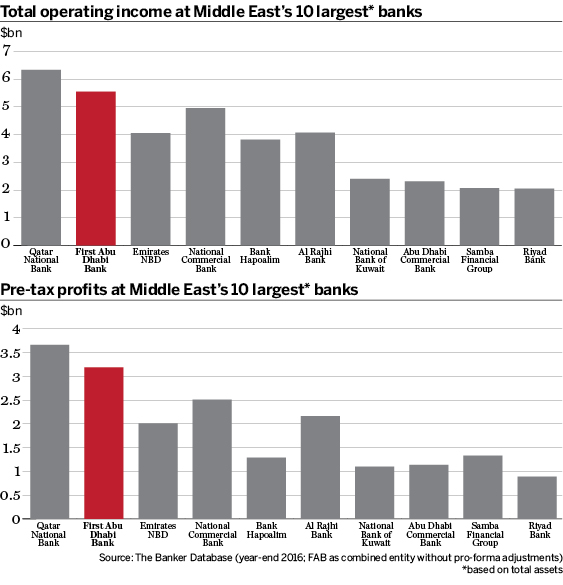The merger of National Bank of Abu Dhabi and First Gulf Bank has created the Middle East’s second largest lender. Danielle Myles looks at what each brings to the combined entity, and how this changes the regional banking landscape.
In early April, National Bank of Abu Dhabi (NBAD) and First Gulf Bank (FGB) completed their merger, and the combined entity began trading on the Abu Dhabi Securities Exchange under the name First Abu Dhabi Bank (FAB).
The combination of the United Arab Emirates’ second and third largest banks by Tier 1 capital – a transaction that Mergermarket has valued at $14bn – was a watershed for the Middle East banking sector. It is nearly a decade since the last major UAE bank tie-up, when Emirates Bank International and National Bank of Dubai merged to create Emirates NBD in October 2007.
With some $181.27bn in total assets, FAB is now the UAE’s largest lender, knocking Dubai-headquartered Emirates NBD from the top spot. FAB is also the second largest bank by assets in the Middle East and north Africa, trailing only Qatar National Bank (which has $197.71bn in assets).
Group CEO Abdulhamid Saeed has said that as a stronger and larger entity, FAB will be able to drive strong profitability and deliver significant value for shareholders. Data collected by The Banker suggests his claims have merit. Combining key items of the legacy banks’ 2016 income statements (without pro-forma adjustments) provides a gauge of how FAB may have fared in 2016 against its regional peers.
The bank’s $5.55bn of combined total operating income is second only to Qatar National Bank. However, FAB should keep a close eye on third placed National Commercial Bank, based in Saudi Arabia, which has grown total operating income by 53% in the past five years, and its domestic rival Emirates NBD, which has grown total operating income by 46% since 2012.
In reality, NBAD had the sixth highest operating income in the Middle East and north Africa in 2016, with $2.94bn, and FGB seventh with $2.6bn. Considering that at the end of 2016 NBAD was 71.6% bigger than FGB by total assets, and 41.7% bigger by Tier 1 capital, the smaller of the two clearly brings much value to the merged business.
The banks’ complementary strengths – NBAD as the region’s standout investment bank and FGB with its leading consumer business – have been touted as a key rationale for the merger. While NBAD’s net trading income in 2016 was 125% bigger than its consumer-focused partner, their net interest income was broadly on par as a percentage of their respective total operating income.
FAB also would have placed second in 2016 Middle East and north Africa rankings for pre-tax profits. The lion’s share of its $3.19bn pre-tax profit would have come from FGB, which recorded $1.66bn compared with $1.53bn reported by NBAD.
This would put FAB comfortably ahead of National Commercial Bank and Al Rajhi Bank, which posted $2.51bn and $2.16bn in pre-tax profits, respectively. Historically, NBAD and FGB’s pre-tax profits were closely aligned with the likes of Saudi’s Samba Financial Group and Israel’s Bank Hapoalim. Their merger promises to elevate them from this chaser pack into the top profitability tier.
Based on pro-forma financial statements prepared by FAB (including adjustments) in relation to the first quarter of 2017, the merged bank has started operations on a firm footing. Its non-performing loan ratio is 2.5% while its common equity Tier 1 ratio is a healthy 14.7%. Compared with the first quarter of 2016, quarterly profit is up 12.4%, loans and advances grew 4.6% and group revenues increased 8.5%.
All data sourced from www.thebankerdatabase.com and First Abu Dhabi Bank’s May 2017 investor presentation.



